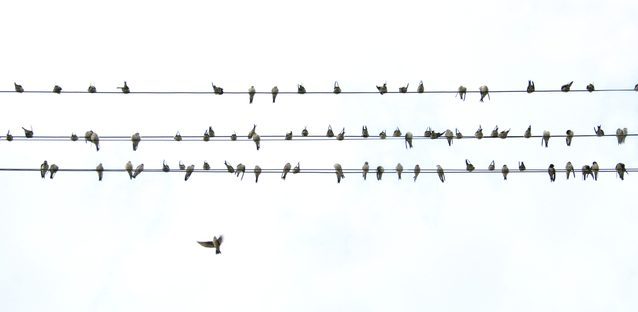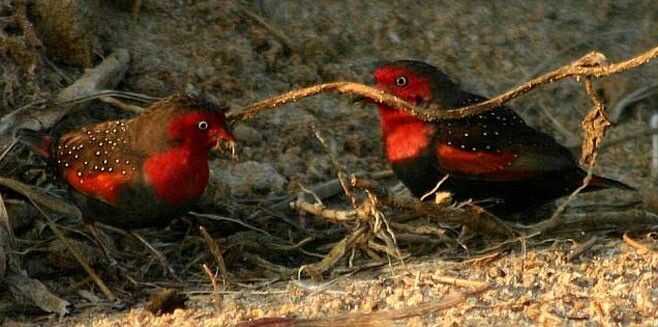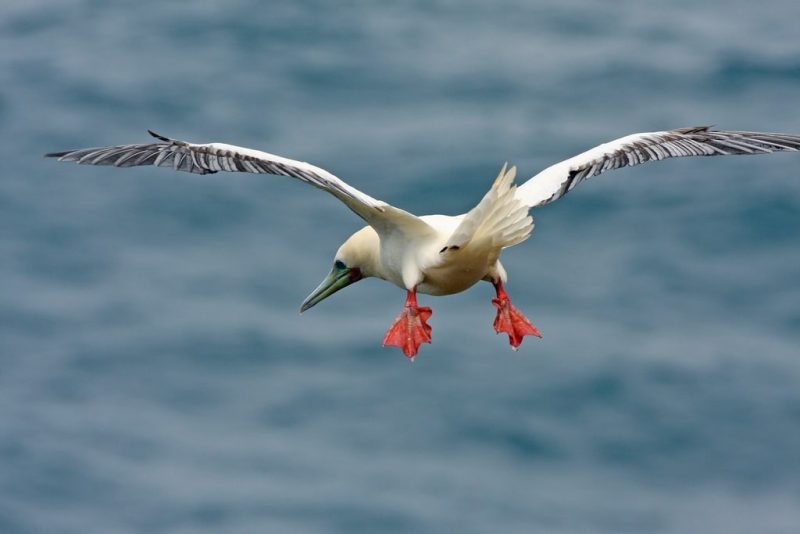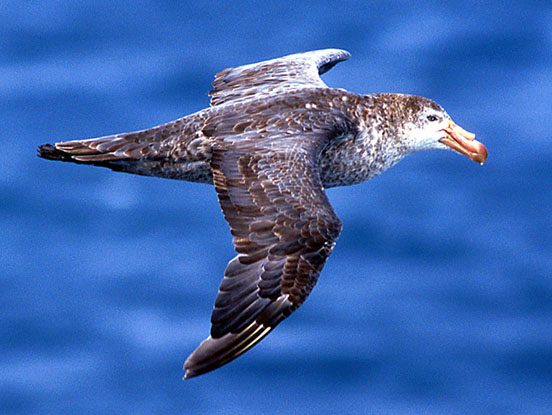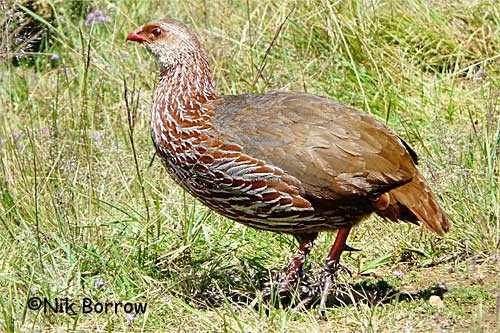Travel To Kenya To Get To Know The Birds
Indigenous birds
The best time to spot one of the endemic birds of Kenya is from October to April. They are a regular feature while on a standard safari in the game parks of Kenya. Although Kenyan endemic birds found exclusively in the region are few and far between, there are credible documents of the sightings of each of the species. Such reports provide detailed information on important recognition features, some behavioural traits as well as distributional points of each of the species. The endemic birds of Kenya are Jackson’s francolin, William’s lark, Hinde’s pied babbler, Taita thrush, Sharpe’s long-claw, Clarke’s weaver, Tana river cisticola, Aberdare cisticola and Sokoke scope-owl.
1) Jackson’s francolin
One of the birds that are relatively common in Kenya is Jackson’s Francolin. It is a bird widespread in the nation’s upper reaches of highland forests and Cherangani hills as well as Mt. Elgon on the country’s border with Uganda. It appears on montane moorland, bamboo zone and giant heath on either side of the Rift Valley. This large montane francolin forages in thick shrubby growth and the nearby openings and often occurs on dirt roads and tracks during damp climates. The females are noticeably smaller than the males. Its feathers are chestnut above and white below. The juvenile is duller with barring on their bellies. Although common, this bird is rather secretive and shy.
2) William’s lark
Larks are small terrestrial birds that are somewhat dull in appearance. However, the general coloration of its feathers matches the lava rocks and red soil of its habitat. And it scuttles rodent-like among small shrubs and rocky plains north of Marsabit and east of Isiolo. Interestingly, its proud display of flight is slow, laboured and jerky in which body and tail hang vertically. In addition, they have a fantastic song of thin, scratchy notes with sharper ones toward the end. To clarify, William’s lark was discovered in Kenya as recently as 1955. Hence its ecology, threats, distribution and population parameters remain little known.
3) Hinde’s pied-babbler
Mainly confined to a small area East and South of Mt. Kenya, Hinde’s pied-babbler has many threats within its range. But this bird is exclusive on the fringes of cultivation, river valleys, seasonal springs and streams. Although it prefers the Lantana thickets in Kianyaga for cover, nesting and roosting sites, maize farms and coffee plantations are its preferred feeding sites. Where the Lantana thickets are lacking at Machakos, Hinde’s babbler appears largely confined to thick riverine acacia woodlands. The density of the species is lower at the less intensively cultivated Machakos than at the intensively cultivated Mukurweini. Increased agricultural development coincides with the reduction in the range of this species.
4) Taita thrush
Prevalent to the remnant Taita hill forests of Kenya, the Taita thrush is a critically endangered species from the family of thrushes and is a distinct species. It is usually seen feeding on the ground and very rarely perches more than 3m above. It avoids secondary growth, cultivation and scrub. Further, the young of this species are duller and browner on scapulars and upper-parts. And the wing-coverts have orange tips and shaft streaks.
5) Sharpe’s long-claw
The English name of Sharpe’s long-claw came into being in the 19th century in memory of the British ornithologist Richard Bowdler Sharpe. However, there are only about 19,000 of these weaver-like birds left and the bulk of them are in Mt. Elgon slopes, Uasin Gishu grasslands, Kinangop Plateau and Mau Narok. Sharpe’s long-claw is a very sedentary bird. As a result, they depend on tussock grasses for nesting, feeding and protection from predators. These grasses grow in clumps or tufts in the dry habitats of high elevations.
6) Clarke’s weaver
A small and fragmented range of Clarke’s weaver is rife in coastal Kenya, north of Kilifi, with the largest sightings in Arabuko-Sokoke forest and fewer in Dakatcha woodland. However, the entire area of woodland and vicinity are changing because of plans to establish plantations of Jatropha for biofuel. Clarke’s weaver feeds high up on fruits, beetles and caterpillars. They are found in noisy and erratic flocks of mixed species birds. This weaverbird is variably absent during the rains when it nests and raises its young elsewhere. Its breeding area is still a mystery.
7) Tana river cisticola
Rumour has it that Tana River cisticola is abundant in Somalia, but it is baseless. This small and long-tailed bird is only rampant in the subtropical or tropical moist shrub-land and grasslands of Eastern Kenya. It has a short-pointed beak and a silver coloration with a sound similar to rattling. Further, this cisticola is insectivorous. And its main diet is grasshoppers. Since the bird is considered to be extinct due to the destruction of its habitat, there is not much information available on its life cycle.
8) Aberdare cisticola
The most peculiar feature of Aberdare cisticola is its short almost non-existent neck. This small bird, endemic to Central Kenya, has beautiful feathers streaked with white. It inhabits high grasslands and mountainous areas. The Aberdare cisticola forages the ground for insects and beetles with its sharp claws and strong bill. Although most of the habitats of this bird have legal protection, it is listed as endangered due to habitat loss to agriculture and livestock production.
9) Sokoke scope-owl
Discovered in 1965, the Sokoke owl is primarily pervasive in the Arabuko-Sokoke forest of coastal Kenya, occurring in dark brown or grey-brown plumage. The face is light rufus, with whitish and buffy eyebrows. The large eyes provide excellent eyesight for hunting for prey at night. This owl has a soft call, which it repeats ten times a minute, most frequently heard just before dawn or after dusk.
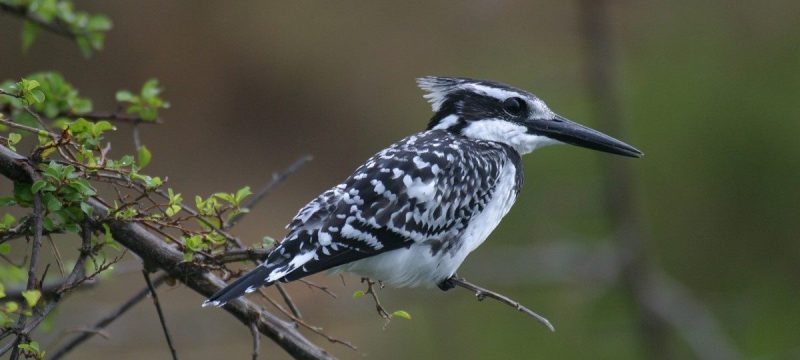
Travel to Kenya to get to know the birds
Introduced birds
While watching birds during a safari, it is easy to mistake a bird to be a member of a localized population especially if there are hardly any visible differences in their physical features. But, fascinatingly, many birds in Kenya are not endemic or indigenous. Human beings introduce them to the country directly or indirectly. World explorers and biologists play a significant role in the existence of such birds in Kenya. An amateur bird lover may not pay much attention to the status of the birds in the country. However, for an ornithologist who studies particular bird species, it is rather important to know about the evolutionary patterns of those birds. There are particularly two Kenyan birds introduced through human intervention. They are the yellow-collared lovebird and house crow.
1) Yellow-collared lovebird
Known as masked lovebirds, yellow-collared lovebirds are very amiable and strikingly beautiful with the bare white skin around their eyes. They are called lovebirds because they maintain the same mate throughout their coupling life and preen and groom each other. They mainly inhabit the southeast of Lake Victoria and portions of Naivasha in Kenya. People keep them as cage birds in America and Europe. They require easy and convenient access to water because they drink several times a day. One particular characteristic of these lovebirds is their ability to mimic human voices in captivity. They can articulate different sounds and change the sound of their voices because of the thick, fleshy tongue. However, it is not common.
2) House crow
Brazen and conspicuous in Kenya, house crows live in close association with human beings. Its presence in Kenya, especially in the coastal region from Mombasa south to Diani, negatively impacts the population of native birds. The increasing numbers of house crows in the country are partially due to the uncollected garbage.
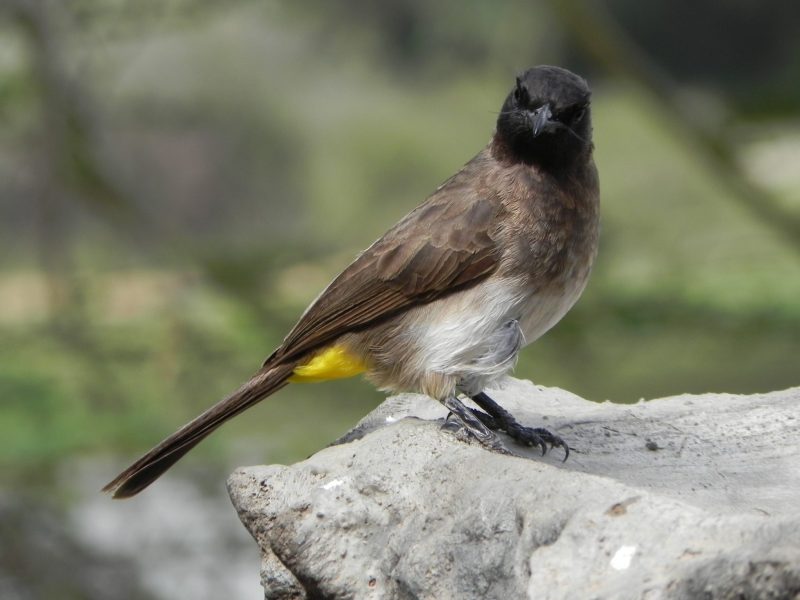
Travel to Kenya to get to know the birds
Forgotten birds
Serious birders, while wandering around the vast outdoors of Kenya, encounter some birds that have been lost and forgotten for the longest time. Such birds are the storm petrels, bee-eaters and other such sundry rare birds.
1) Storm petrels
Apart from shearwaters, the order Procellariiformes also consists of storm petrels, which are the smallest seabirds in the world. They feed on tiny fishes picked from the surface and planktonic crustaceans, typically while hovering. They are the black-bellied storm petrel and leach’s storm petrel.
a) Black-bellied storm petrel
On the 27th of June 1988, biologists found a fresh carcass of a black-bellied storm petrel on Watamu beach representing the first Kenyan record for this species. It had lost its left leg but was otherwise entire. It was not a juvenile owing to wing feather condition and age. The bird was identified quickly because of its distinctive plumage. Later on, in 1994 another one was found dead in Malindi. The main feature distinguishing this species is a black stripe from its dark chest to the under-tail coverts.
b) Leach’s storm petrel
Dark plumage contrasting the pale upper wing bar and rump patch with a forked tail are the main characteristics of a leach’s storm petrel. It is a rare Kenyan bird. During the nonbreeding season, this bird is primarily pelagic and is only being found inshore during storms. They feed on crustacean, small fish and invertebrates. It sometimes follows cetaceans while foraging. A beached specimen was found dead south of Mombasa in 1967. There are further records of three sightings in April, October and December of the same year in Kilifi, Watamu and Mtwapa.
2) Bee-eaters
The near passerine birds belonging to the Meropidae family are called the bee-eaters. Most of them are African species out of which some are from Kenya. They have coloured plumage, elongated central tail feathers and slender bodies. All have pointed wings and down-turned bills and appear like swallows when seen from afar. They are the swallow-tailed bee-eater and southern carmine bee-eater.
a) Swallow-tailed bee-eater
Preferring eucalyptus plantation and tall savannah woodlands, the swallow-tailed bee-eater’s diet consists primarily of insects, especially bees. It locates its prey from low perches. Once they find the victim, it rapidly flies at the insect and kills it by repeated banging. If the victim is poisonous, they rub the sting against a hard surface until they secrete all the venom. Both sexes excavate the nest, which they usually dig into riverbanks or sandbanks. The chicks are fed butterflies, wasps and bees by both parents. There are unverified, old reports of specimens from Shimba and Vanga Hills.
b) Southern carmine bee-eater
By painting the sky with a blur of color using their fabulous feathers, the southern carmine bee-eaters announce their arrival by mid August. Up to a thousand of them can congregate and they make a spectacular sight. They migrate for breeding purposes and stay for three months. Like heat-seeking missiles, they swirl and swoop through the air. The act of catching bees in mid-flight is a sight to be reckoned.
3) Sundry rare birds
An account of the precious birds of Kenya is incomplete without an account of the most extraordinary of the unique birds. They are the southern gray shrike, Jackson’s pipit, ortolan bunting, orange weaver and broad-tailed paradise-whydah.
a) Southern grey shrike
While being perched on an exposed and prominent tree, the southern gray shrike moves its tail up and down. When it finds its prey on the ground, it dashes to the victim. The eye patch of these birds is extensive, in sharp contrast with white cheeks. Southern gray shrikes are resident birds, with only some short distance movements. It is an accidental bird in Kenya.
b) Jackson’s pipit
Unlike many African pipits, the head and back of Jackson’s pipit is the same color, marked with white bands. Also, the under parts differ in being buff instead of white. The outer tail feathers are white and many of the feathers have buff edges. The Jackson’s pipit’s bill is dark with a pink mandible and has a white eyebrow that curves behind the cheek. A dark stripe separates this latter from the throat.
c) Ortolan bunting
The appearance of an ortolan bunting is rather beautiful and impressive with its upper parts greyish brown, a distinctive yellow eye ring around the brown iris, brownish pink legs and a pink beak with a black tip. They build their nests on the ground using long dry grass and line them with hair.
d) Orange weaver
Some biologists consider orange weavers its species. It is also called the northern red bishop. They are long-lived, robust and are prone to obesity. The cocks seasonally enter a colourful black-and-orange plumage and the feathers around the neck fluff outward. The hen is smaller and has darker streaking on the under-parts and cheeks. The species is polygamous. They become aggressive when they come into nuptial plumage. When not breeding, they tend to become pests to crops. Orange weavers should be given regular bathing opportunities as they love to bathe.
e) Broad-paled paradise-whydah
Each whydah species tends to mimic its host’s song, interspersing its innate motifs, to attract hens. These birds do not build their nests. They lay their eggs in others’ nests. A single female whydah lays around 22 eggs in a season. It does not remove the eggs of the hosts. In fact, fledging data suggests that this behaviour does little damage to the productivity of the host. Although baby whydahs mimic the host species to avoid detection, some differences are noted. The host then raises the chicks alongside their own. Whydahs are thought to mimic the vocalizations of their parents via imprinting.
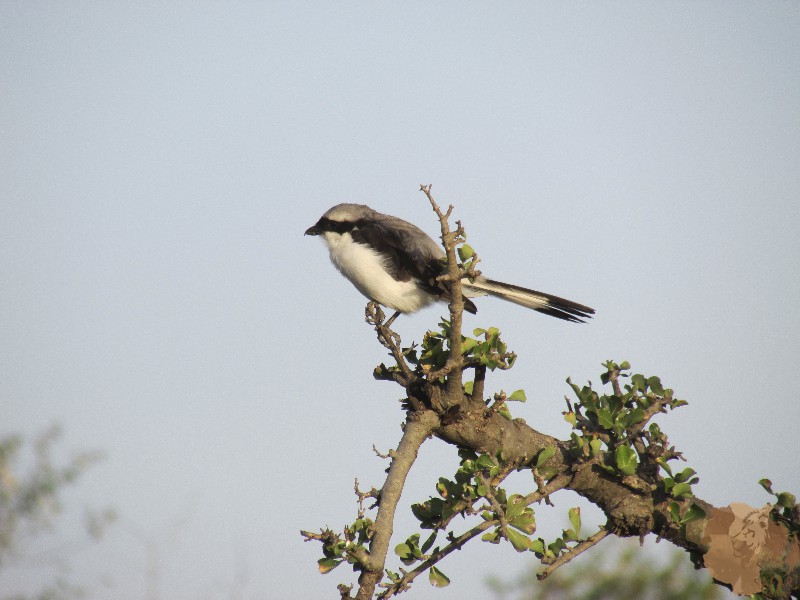
Travel to Kenya to get to know the birds
Nomadic birds
Some of the birds in Kenya that was once abundant suddenly become nomadic due to various reasons. People only come across them accidentally. Nature plays a prominent role in locating and relocating them around the world. Many such birds have wandered into the territories of Kenya as well. Ornithologists and bird lovers accidentally stumble upon them and record their findings after careful research. A few species belonging to shearwaters, flycatchers and ducks as well as red-footed booby, Egyptian plover, northern lapwing, black-winged pranticole, European turtledove, short-eared owl, long-tailed nightjar, blue-breasted kingfisher and lowland sooty boubou are among them.
1) Shearwaters
Belonging to the order of Procellariiformes and the family of Procellaridae, shearwaters are also called procellariids. They have united nostrils and a long outer functional primary. They are the cape petrel, Antarctic prion, wedge-tailed shearwater and sooty shearwater.
a) Cape petrel
The only member of the genus Daption is the cape petrel. Their nasal passages are attached to the upper bill. They secrete stomach oil made up of triglycerides and wax esters, which they spray out of their mouths to protect them from predators and as an energy food source during long flights. Also, cape petrels have a salt gland that excretes a saline solution from their nose, which helps desalinate their bodies caused by the high amount of ocean water. This unique looking petrel’s main diet is crustaceans and is aggressive while feeding. They obtain fish, squid and krill by diving underwater and surface seizing. They are also known for following boats and eating carcasses and edible waste thrown overboard.
b) Antarctic prion
One of the largest and the most cosmopolitan of the prions is the Antarctic prion. Its other name is dove prion. It uses a feeding style called hydroplaning. Using this strategy, they alight on the surface of the water and use its feet to propel rapidly forward with its head partially submerged. This method utilizes its lamellate bill to filter crustaceans. The Antarctic prion has expandable skin on the lower mandible, which it uses to form a gular pouch that aids in filter feeding.
c) Wedge-tailed shearwater
The well-bowed shape of the tail gives the wedge-tailed shearwater its name. They are held forward and slightly higher than the body. While taking off, the birds flap up their wings slowly and then glides towards the water, speeding up according to the strength of the waves, and often progressing lower in arcs, before rising and sliding down again. They are relatively large birds. As much as its bill is dark, the legs are very pale and almost invisible from far despite their massive size. Several records of sightings in coastal Kenya between Shimoni to Lamu exist. And a maximum of 12 wedge-tailed shearwaters has been seen off Mtwapa.
d) Sooty shearwater
One of the most common seabirds is the sooty shearwater. It is also one of the top predators in the system. Ironically, they suffered a 90% decline in their population. The oceanic temperature increase and the decrease in zooplankton are direct causes of its current survival status. There is enough evidence to suggest that the recent trends in global warming and atmospheric changes negatively impact the plant growth and productivity.
2) Flycatchers
As the name suggests, flycatchers are a group of small passerine birds of the ancient world. They are small arboreal insectivores. Their appearance is highly varied, but they have harsh calls and weak songs. They are the European pied flycatcher, collared flycatcher, black-eared wheatear and desert wheatear.
a) European pied flycatcher
The male European pied flycatcher has white spots on their foreheads. The size of these marks correlates with its attractiveness to a female. It also indicates the male’s competence. Their plumage is ultraviolet reflective to make it appear bright in the eyes of the hen. They use these to attract individuals of the opposite sex. In some populations of the southern parts of their range, the hen may have these patches as well. For the females, the spots are a sign of old age, rather than health. Larger blotches have also proved to connect with fewer trypanosome infections. Both polygyny and monogamy occur in this species. But polygyny represents a cost to males because they are more likely to be cheated by the mates, leaving them to raise the chicks. One of the quickest and best ways to judge the cocks is to listen to their songs. Both bright plumage and complex songs indicate good fitness.
b) Collared flycatcher
Researchers at Uppsala University found that the forehead patch size of collared flycatchers changed owing to the rising spring temperatures in their breeding sites. This characteristic might be the beginning of a new natural selection. Evolution magazine published these results, which includes 15 generations. The related data and subsequent research contributed to an understanding of the effects of climate change on the nature of evolution.
c) Black-eared wheatear
In summer, the black wings, white body, tail and mask of the male black-eared wheatear are more pronounced and highly conspicuous when perched on an exposed low tree branch or a bush from which it pounces on insects. The species is a summer visitor, where it is abundant on lightly wooded and open arid flatlands and hillsides.
d) Desert wheatear
True to its name, the desert wheatear is of the open desert origin and camouflages itself very well with its cream-colored upper parts, creamy buff plumage tones and distinct frosty-white scapulars in all plumages. The all-black tail is also unique to these birds. They are relatively shy and remain tucked away in the desert. But when found, they are full of character and inquisitiveness.
3) Ducks
Along with geese and swans, the Anatidae family includes ducks, which are adapted to an aquatic existence and are excellent at shedding water owing to an oily coating on their feathers. These birds have webbed feet and flattened bills. The birds that belong to this category are mallard and common pochard.
a) Mallard
One of the most vagrant ducks found in Kenya is mallard. No satisfactory recent records exist about this bird and no specimens preserved. However, there are traces of them near Marsabit. A peculiar feature about this duck species is that they have two black tail feathers that curl up and forward.
b) Common pochard
One of the vulnerable duck species of Kenya is common pochard, whose population crashed spectacularly over the past two decades. It is now critically endangered. Common pochard is an open-water, stocky diving duck with a steep forehead and long bill. Their young may show remnants of brown plumage in early winter.
4) Red-footed booby
All red-footed boobies have legs that are red, which gives them its name. Red-footed boobies nest on land but feed at sea. The number one threat to red-footed boobies is coastal development and a fishing industry that makes their food source scarce. The shoreline shrubs and the trees these birds frequent are disappearing as people consume more of the coastlines. These well-known seabirds are even familiar to boaters as they often readily follow marine craft, often perching on rigging. Boobies are high fliers and are nimble enough to trap flying fish from the air. They are also well adapted for diving underwater. These gregarious birds have long bills, closable nostrils as well as aerodynamic and lean bodies. They wrap their bodies with long wings before diving using these attributes to capture fish that they spot with their sharp eyes. Squids are more visible at night because of their phosphorescence, and hence the birds hunt them at night.
5) Egyptian plover
Exceptionally fearless and one of the tamest of birds, Egyptian plover lays its eggs on an exposed patch of the riverbed and uses sand to incubate them. A newborn chick takes the first drink from the wet feathers of its parents. This terrestrial bird is very bold in the presence of crocodiles. They reputedly run across the crocodile’s back and pluck food from the open mouths of crocodiles. They live happily alongside villagers. This spirited bird resembles a wind-up toy with its quick-stepping gait as it races across the ground.
6) Northern lapwing
As mainly diurnal feeders, northern lapwings eat sugar beet stubbles but invertebrates, worms, fish, seeds and other plant material are also a part of their diet. These precocial shorebirds are dark with white below, green gloss above and a long black crest. The dark marks on cheeks and around the eyes contrast with the otherwise buffy white face. Northern lapwings use song-flights to communicate. A song-flight is a music-sequence combined with a series of flight types. Due to competition for male care, females show three types of behaviour towards female intruders. The first is a run towards the intruder with a retracted neck, an erect chest and ruffled feathers. When face-to-face, there is a performance of displays and crouching. But the most common behaviour is the second behaviour, which is a string of attacks including pecking, kicking or hitting. The third is an aerial attack towards the intruder. Males tend not to exhibit these behaviours.
7) Black-winged pranticole
The nests of black-winged pranticole are loose colonies or several hundreds of pairs on open ground. Sites may move annually, even when still suitable. Around 60% of clutches and chicks die every year because of trampling of nests by grazing cattle, increased predation, heavy rains and severe droughts. The few Kenyan records are in north of Marsabit as well as in lakes Naivasha and Baringo.
8) European turtledove
Ecologically unique, turtledoves are the only long distance migratory doves. They are obligate granivores. Their diet consists exclusively of seeds. Turtledoves roost in acacia thickets, sites that are safe from disturbance and predators. The lack of available weed seeds, as well as a switch to grains, is the direct cause of a reduction in their nesting attempts. Hunting may also represent a significant threat, with an increase in the number of European hunters visiting Kenya. Another emerging potential cause of its decline is the disease trichomoniasis. Knowledge about turtledoves beyond their breeding grounds is limited.
9) Short-eared owl
The world’s most common owl is the short-eared owl. It is also the most frequently seen owl in daylight. The ear tufts of short-eared owl are so short that they are often invisible. But the black-rimmed yellow eyes are its most conspicuous feature. At dawn and dusk, these birds course over grasslands, giving their flight a moth-like quality, by flapping stiffly with their rounded wings. They can travel long distances. Witnesses have reported seeing them descending on ships many miles from land. The females usually are reluctant to leave the nest. So, they often defecate on their eggs, causing a putrid smell that repels predators. Short-eared owls use acute hearing to prey on small mammals and birds. They decapitate small mammals and strip the wings of birds before swallowing them whole.
10) Long-tailed nightjar
An unusual thing about long-tailed nightjar is its serrated middle claw, which it uses to preen the feathers. However, the function of these talons is uncertain and may have nothing to do with ectoparasite control as was earlier believed. It is not easy to see these nails when resting on a low perch or the ground. But these pectinate claws tend to stick out occasionally because they are longer than the others. Long-tailed nightjars are residents near Lokichogio.
11) Blue-breasted kingfisher
The adult blue-breasted kingfisher has a bright blue head, wing panel, back, breast band and tail. The hefty bill and legs are coloured red. The plumage is turquoise-blue and the abdomen and throat are white. The shoulders are black.
12) Lowland sooty boubou
The most conspicuous and distinguishing morphological feature of lowland sooty boubou is the blue-gray iris. This forest bird is a vagrant in western Kenya. Its song is fluty whistle followed by the female’s grating sound.
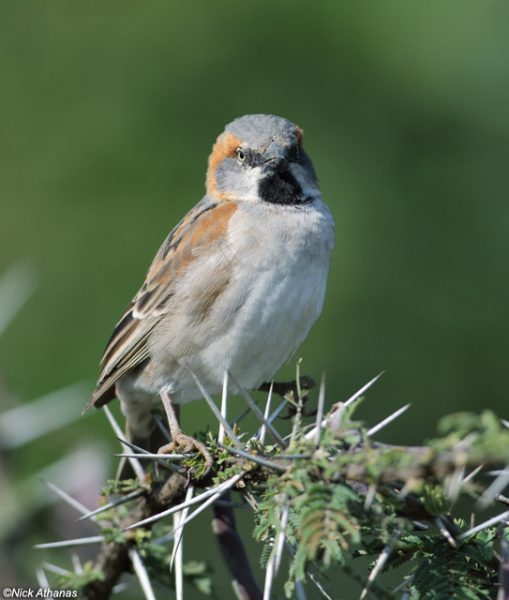 Rare birds
Rare birds
Watching the chirping and tweeting of birds is fascinating enough for birdwatchers, photographers, safari travelers and amateurs. But what is even more fascinating is stumbling upon rare birds when they crisscross the country. The spots in Kenya where people discover rare birds cover a vast ecological area from the south to the coast of the country. They have recorded many sightings of such ones. However, unfortunately, they have not been officially confirmed. Hence, they go unnoticed. The scant amount of information is also due to their rarity. They are only stumbled upon accidentally and are often shy of human beings. The species such spotted are the southern giant-petrel, brown skua, forest wood hoopoe, speckled tinker-bird, waxbills, sandpipers, gulls and terns.
1) Southern giant-petrel
The more common southern giant-petrel is grey-brown with a fair face although the birds come in two distinct color morphs. The rare white morph is pure white with random small black spots. They are silent birds but tend to be very noisy when squabbling over food. They possibly occur as a vagrant in coastal Kenya.
2) Brown skua
An opportunistic scavenger and predator, brown skua, feed on a broad range of animals and attack all birds. However, they show a preference for killing seabirds, forcing the victim underwater following plunge diving. Although they feed mostly by scavenging fish, some populations hunt prions and petrels mainly at night, digging them from shallow burrows.
3) Forest wood hoopoe
Formerly called the red-billed wood hoopoe and more commonly known as greenwood hoopoe, the forest wood hoopoe is a bird native to Africa but is now rare in Kenya. Sadly, extensive deforestation in the country precludes any likelihood of the bird’s return. They live in groups with only one breeding couple. The female lays eggs in an old barbet nest or a natural tree hole and incubates for 18 days. Upon hatching, the entire group feeds the chicks and defends them against intruders. This conspicuous bird advertises its presence with its loud call and other vocalisations.
4) Speckled tinker-bird
Plump-looking birds with rather large head, the speckled tinker-bird have a hefty bill fringed with bristles. They are mostly solitary and visit plantations to feed on cultivated fruits and vegetables. They are believed to be agents in seed dispersal because after eating a whole fruit, they regurgitate indigestible material such as seeds. Speckled tinker-bird also eats insects such as ants, dragonflies, cicadas, crickets, locusts, moths, beetles and mantids. They usually nest in holes of dead trees, stumps or branches. The hen lay between 2 to 4 eggs. Parents share the nesting duties. Tinker-birds place sticky mistletoe seeds at the entrances of their nests to deter predators. It is hard to find these birds in Kenya these days. However, there is a collection of an old specimen near Kitale in Kenya, and an early sight record exists from Kakamega forest, which remains unsubstantiated.
5) Waxbills
Often gregarious in nature and colonial seedeaters, waxbills have thick, short but pointed bills. They have the same structure and habits but are different in the plumage colors and patterns. They are the locust finch and magpie manikins.
a) Locust finch
Some naturalists place locust finch in the monotypic genus Paludipasser. Although this finch is a rare species in Kenya, small numbers of them exist in parts of Mumias and Busia districts. Locust finches have grey bodies, short tails and full bills but lack the colourful plumage and stay in small flocks or pairs. They frequent open areas and are desert birds that live on the ground. Their remote desert habitat makes them less accessible and very shy by nature. But once they find their bearings they are hardy aviary occupants. When someone approaches this species, his or her response is to crouch. When flushed, they rise straight into the air and then drop straight back down. Finches are sociable seedeaters. They are monogamous unless their mates die.
b) Magpie manikin
One interesting fact about magpie manikin is that its song is virtually inaudible. It can be seen singing without a sound. Courtship displays include sticking out its tongue and jiggling it from side to side. These birds have a reputation for being aggressive. Their population numbers have declined drastically over the past half a century.
6) Sandpipers
A large, diverse family of shorebirds includes the sandpipers whose identification is not so easy as they resemble very closely with the other ocean residents. They compete with the other hosts for food and sustenance. They are the red knot, sanderling, dunlin, pectoral sandpiper, pin-tailed snipe, red phalarope and spotted redshank.
a) Red knot
Researchers use the fecal content to examine consumption rates of red knots, as they do not regurgitate undigested hard parts. Instead, it excretes them. The male of these birds makes an aerial singing display. There exist four records of sightings in coastal Kenya.
b) Sanderling
The black legs of sanderling blur as it runs on the beach, probing and foraging restlessly for small prey in the sand left by receding waves, then retreating quickly before the next breaker. They run with head held low and body horizontal. Sanderlings are primarily medium-sized coastal sandpipers recognizable by their pale plumage, black legs and obsessive wave-chasing mannerisms.
c) Dunlin
Dunlin is a shorebird unique in breeding plumage. Its breast and head are light-coloured, and it has a black belly-patch extending all the way up to its black legs. Dunlins twist and turn in flight. The white patches of under wing become especially distinctive when in flight and are evident even from a distance. Dunlin flocks are most impressive during their aerial manoeuvres trying to escape predators.
d) Pectoral sandpiper
A medium-sized shorebird, the pectoral sandpiper occurs most commonly on mudflats with weedy vegetation or short grass. The breeding male has an inflatable throat sac. During flights, this pouch expands and contracts rhythmically. The accompanying vocalisation consists of one of the most unusual hollow hoots.
e) Pin-tailed snipe
The breeding habitat of pin-tailed snipes is wet marshes and their non-breeding range use wetlands. They are known for their dazzling aerial display, in which up to 15 males plunge sideways, or each one of them falls downwards and glides while uttering cries and producing sounds with modified feathers.
f) Red phalarope
The numbers of red phalarope are hard to measure. However, populations of these birds are thought to have declined owing to climate change. Phalaropes reverse the usual gender roles in birds. In courtship, females take the lead, flying in a full circle, calling and chasing the male in the air, or pursue them on the water with their head hunched down between shoulders. After leaving them to incubate the eggs as well as care for the young, the female finds a second mate. These open-water birds forage mostly while swimming. Often, they spin in circles, probably to stir things up. At sea, they land on mats of seaweed and pick parasites from whale’s back. Their diet during the winter season is rarely known.
g) Spotted red-shank
The slender appearance of spotted redshank is slightly larger than redshanks, and they lack the wing bars. They have a long neck. During summer, their plumage is black with spots appearing on their upper parts. In flight, the legs trail behind the end of the tail. They often wade in deep water with a submerged head.
7) Gulls and terns
The feathers of gulls and terns are either gray or white with black markings on the head. They go with the order of Charadriiformes and belong to the family of Laridae. The rare gulls in Kenya are the fair-eyed gull, kelp gull and little gull. The terns of the country are the black tern, Arctic tern and little tern.
a) Fair-eyed gull
The inner upper wings and the upper parts of the gull is medium-dark grey, and the breast is mid-grey. They have a black hood, which extends down onto the throat. A distinct feature is its slender bill, which is dark crimson with a dark tip and black in chicks. The legs of the gull are yellow and brightest in breeding plumaged adults. The bird gets its name from white eye-crescents. The survival status of this species is threatened because it experiences a moderately rapid population decline owing to predators and oil-spills. If the population declines more rapidly, it might qualify for a higher threat status.
b) Kelp gull
A sizeable black-backed gull, the kelp gull has a white tail and a yellow bill with a red spot. The wing has a trailing edge and a white window in the wingtip. They are gregarious and tend to feed, roost and breed in flocks. They prefer the sheltered parts of coasts. It is likely that they are in serious competition with the Pacific gull because of their similar habits, habitat and food. It is a fascinating sight to watch the kelp gull drop molluscs onto rocks to smash them.
c) Little gull
Worldwide, the smallest gull is the little gull whose origin is something of a mystery. Many think that the species came to Kenya through transatlantic colonisations. Some reports suggest that their diet appears to consist mainly of small fish, invertebrates and flying insects. But remarkably little information exists about little gull, as there have been no biological studies done on possible origins.
d) Black tern
The population of black terns has declined sharply due to loss of nesting habitat owing to runoff of farm chemicals and drainage of wetlands. Lack of food supply due to local overfishing can also be a factor.
e) Arctic tern
When molting its wing feathers, the Arctic tern rarely flies. It spends much of its time resting. Its molt happens so frequently that some individuals are nearly flightless. And they can live for decades.
f) Little tern
Extremely sensitive to human disturbance, the numbers and range of little terns are rapidly declining. Nesting sites are located where humans exercise dogs, walk, picnic and drive. The mere presence of people may cause these terns to leave their eggs and abandon the colony altogether.
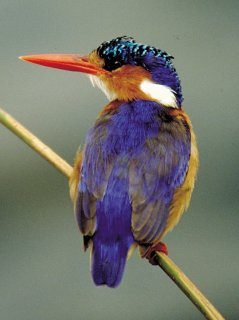 Extinct birds
Extinct birds
Today Kenya has lost many birds at the species level as part of the evolutionary process. Some migrate, but others just go extinct due to various external threats. They belong to the category of hawks, cranes, jaegers and frigate birds.
1) Hawks
Aptly described as birds of prey, hawks belong to the family of Accipitridae and have robust legs, powerful talons, keen eyesight and sharp hooked beaks for tearing the flesh apart. They include levant sparrow hawk, Eurasian sparrow hawk and short-toed snake-eagle.
a) Levant sparrow hawk
The males of levant sparrow hawk are particularly striking at close range. They have blue faces and red eyes. The juveniles have distinctive lines of black spots down below. But the males in the flock are pale below with contrastingly dark wingtips. In flight, the gregarious behaviour of these birds is usually enough to identify them. The shapes distinguish lone birds since their wings are long and pointed. These hawks fly over extensively managed agricultural land. This sparrow hawk becomes sexually mature as early as its first year. They have been found to be breeding with traces of immature plumage. Their nests are in trees along river valleys. They are usually small loose structures of sticks, with the cup lined with leaves. They build new nests every year. Levant sparrow hawks that almost look like falcons are rare migrants to Kenya.
b) Eurasian sparrow hawk
A peculiarity of Eurasian sparrow hawk is the most prominent age difference in any bird species between the sexes. And the male is 25% smaller. Eurasian sparrow hawks are predators who specialize in catching woodland and garden birds in any habitat including urban areas such as towns and cities. Landowners and gamekeepers conflict with these birds because of its behaviour of feeding on birds. In Kenya, Eurasian sparrow hawks are a rare visitor in the open woodland or countryside. Richard Francis Burton mentions the Eurasian sparrow hawk in his famous book One Thousand and One Arabian Nights.
c) Short-toed snake-eagle
Looking from above, short-toed snake-eagle seems brown but down under, its belly and breast are white. They are known to live in the wild for up to 17 years. As the name would suggest, a large part of their diet consists of snakes, both non-poisonous and venomous. In some areas, snake constitutes 100% of their food. They eat the snakes in its entirety. Even three weeks old chicks are capable of swallowing snakes of up to 90mm long. These birds hunt in flight or from a perch. They also follow grassland fires to prey on the animals that did not escape. Kenyan reports of their findings are unsubstantiated.
2) Cranes
The most elegant features of cranes are their long legs and necks. Unlike herons, they fly with their beautiful necks outstretched. Among the group of cranes are the demoiselle crane and common crane.
a) Demoiselle crane
Found primarily in open spaces, demoiselle cranes live in savannahs, grasslands, steppes, high plateaus and upland areas. Solitude and space are essential for the maintenance of these cranes. They are usually less than a hundred meters away from rivers because they need the water to survive. Demoiselle cranes have streamlined bodies and long rounded wings. Their heads have feathers with a white line extending from the back of the head to the corner of the eye. The toes are shorter as the bills can forage for food efficiently in upland areas. There are photographs preserved of eight adults and a juvenile taken near Malindi in 1986.
b) Common crane
The nest of a common crane is usually situated in the dry open land because it is easier to notice any danger and warmer for the young. This crane is not an experienced builder and consists of just a small cavity in the land. After laying the eggs, the female hatches them for a month. It takes half a year for the hatchling to get as big as the adult. The cranes come to fields during the period of sowing, and it never lands in trees.
3) Jaegers
Typically considered as long-distance migrant birds, jaegers are medium to large birds, often with light markings on the wings. The ones in Kenya are the parasitic jaeger and long-tailed jaeger.
a) Parasitic jaeger
Medium-sized of the two jaegers, the parasitic jaeger is quite a keen klepto-parasite. It often focuses on terns and gulls when stealing food. Hence, it is most likely to be seen in coastal areas and closer to shores. To witness this jaeger chasing its victim is to see an exciting and exhilarating acrobatic. The parasitic is slim enough to be incredibly manoeuvrable and big enough to look formidable. Hands down, this bird is the king of the chase.
b) Long-tailed jaeger
Breeding long-tailed jaegers are found both farther inland and near the coast. The pairs advertise and defend their territories with a variety of aerial combats. At other times, they are highly pelagic, spending time in areas with schools of fish and commercial fishing vessels. They often migrate singly over the open ocean. They are the most graceful and agile as well as the least aggressive of the jaegers.
4) Frigate birds
People have seen frigate birds in Kenya’s coastal town of Mombasa. These birds usually live in tropical oceans. Among them are the lesser frigate bird and great frigate bird.
a) Lesser frigate bird
The axillaries are the distinguishing feature in all ages of the lesser frigate bird but can be hard to notice accurately in the sea or from a distance. There are numerous stages to full adult plumage. It is an extremely vagrant bird in Kenya with the last official recorded sighting documented in Watamu in January 1980 and Malindi in 1994. Although unidentified frigate birds live in Kenyan waters, no evidence supports a published report.
b) Great frigate bird
Being high fliers, great frigate bird spends most of the time flying, rarely flapping their wings. Their plumages lack waterproofing, and they do not have webbed feet. Hence, they cannot dive for food in the water, but pick their prey from the surface of the water or attack other birds and make them give up their prey. They build twiggy nests on mangrove tops. The males use an inflated red throat pouch to attract females. Outside the breeding season, this sac is usually invisible. Young chicks are dependent on the parents for a year. So, they can only breed every few years. Every year during August, most of the unidentified frigate birds seen at sea off the Kenyan coast probably are this species. A few records of sights exist including a skull from Kiunga and a specimen from Tana River.
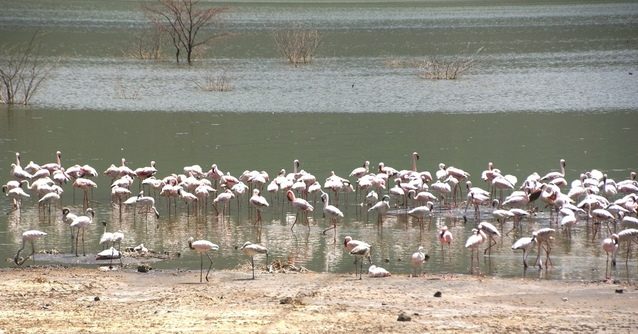 Flamingo
Flamingo
One of the components of a wildlife safari package to Kenya is a well-deserved visit to Lake Nakuru. The well famous and beautiful Lake Nakuru of Kenya is situated in Nakuru national park in the province of rift valley, which borders the neighbouring country of Uganda. This lake is home to 13 threatened bird species in the world and the highest bird diversities globally. Freshwater streams from the mountain surround the magnificent Lake Nakuru. They trickle through moss-covered rocks, nourishing the green leaves and long grasses sweeping low to the ground. An incredible feature of the lake is the large gathering of long-necked, long-legged greater and lesser flamingos. Flamingos populate the streams as they bathe and frolic in the mountain water, rinsing off the salt that would otherwise harden their feathers, rendering them unable to fly. The lake is undoubtedly a flamingo par excellence.
Greatest avian spectacle
Spectacularly pink in color and shaped oddly atop tall, stilted, bald legs with knees that bend backward while walking, flamingos are the most iconic birds on earth. Two-thirds of the population of flamingos occur in southern and East Africa. Scientists reckon that the numbers of these marvellous water birds at Nakuru is often more than two and a half million. The birds rely on distinct environments in which to hatch their eggs, and never breed in captivity. Interestingly, when heading for their breeding area, the flamingos fly in gorgeous V formations. It is an exceptional sight to watch the birds taking off in a surge from the surface of Lake Nakuru, revealing the blue water under their crowded wings. The number of flamingos flocking Lake Nakuru is so astounding that visitors touring this semi-arid region cannot help but visit this place. Tourists to Lake Nakuru and ornithologists alike describe it as the greatest spectacle in the world. It is not a scene replicated anywhere in the world due to the particular environment required by the birds. Hence, making a trip to Nakuru National Park is a must.
Differences
The lesser flamingos are differentiated from greater flamingos by rosier features, crimson legs and a darker beak, while their smaller size becomes more noticeable when the two of them are together. The most prominent and distinguishing feature of the lesser flamingo is its pink plumage and deep red carmine bill unlike the greater flamingo, whose bill has a black tip.
Favourite cuisine galore
Lake Nakuru in rift valley is the most important foraging location for the lesser flamingo anywhere. The abundance of the blue-green alga called cyanobacteria in the lake attracts the flamingos that line the shore. Impressively, they consume about hundreds of thousands of such algae per hectare every year. The algae come from their droppings that get mixed with the plankton in the warm alkaline waters. The flamingos eat them by dipping their large beak into the water and eject nutrients through their nasal filters, and in the process, retain the cyano-bacterium, algae and spirulina that they feed. Thereby, the nutrients that they leave give the lake its blue-green color and the pigment in spirulina gives the birds their pink hue. Lake Nakuru has grown in significance and size and offers a rare vision of the lofty birds dipping their necks in search of their morsel.
Threats to survival
The survival of flamingos, unfortunately, is being threatened by several factors, as they require a very highly specialized diet and habitat. Recently, flamingos have been decreasing in numbers due to pollution resulting from industries, an excess of tourism, water works nearby dumping waste into Lake Nakuru and changes in the quality of water, which makes the lake inhospitable. In recent years, there have also been wide variations in the wet and dry seasons’ water levels. The collective watershed land conversion, intensive crop production and urbanization reduce the soil’s capacity to absorb water and recharge groundwater causing increased seasonal flooding during the wet season. The increasing rise in the water levels of the floods adversely affects the ecosystem of the lake. On the other hand, during the dry season when the lake recedes, drought and pollution destroy the flamingos’ food. These phenomena have caused a drop in the salinity of the water causing them to migrate elsewhere. Today, the majority of the pink, massed flocks are seen more at the other Rift Valley lakes such as Bogoria, Elmenteita, Magadi, Simbi Nyaima and Natron. They migrate in unison between the lakes in the Rift Valley not only as the food sources deplete but also when the season to breed arrives. It implies that a positive change towards their survival status depends on enhancing the environment that they live.
Mitigating survival risks
Regulations and favourable state policies can bring about drastic changes in the habitat of flamingos as well as eradicate the depletion of their food sources. Promoting eco-tourism within the region and implementing measures to reduce pollution can make Lake Nakuru a more hospitable habitat for these exotic birds. Alongside, the government should have strict penalties for those culprits who use the lake as a dumping ground. Doing damage control is a good starting point to improve the quality of the lake water. Part of the tourism revenue must go for this purpose. Failure to do so would be at the peril of making the flamingos extinct sooner rather than later.
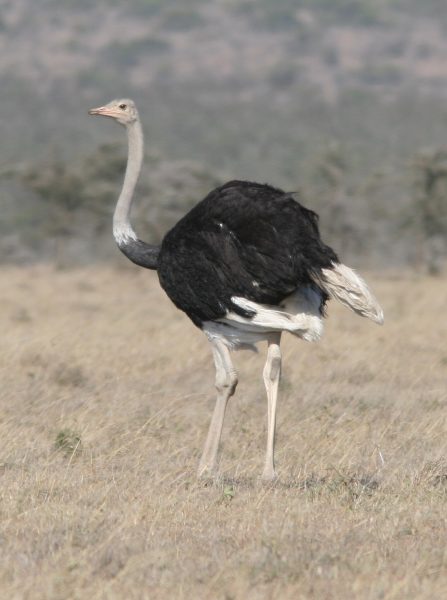 Ostrich
Ostrich
Ostriches have inspired civilizations and cultures for many centuries in Mesopotamia and Egypt. Today, it is found natively in Africa. There are five species of ostriches around eastern and central Africa. The different species are similar but vary in color and size. The ostrich is closely related to the New Zealand kiwi and the Australian emu. It is the largest bird in the world with a male ostrich growing around 2 meters tall. An average ostrich weighs around 200lb or 100kg and measures 7-9ft in length. Hence, it is too heavy to fly and remains a flightless bird. But the flightless ostrich has the biggest eye of any animal. It measures 5cm across, allowing them to see predators at very long distances. The ostrich’s wings reach 2 meters and are used to shade chicks, in mating displays, to cover the skin of the upper legs, to conserve heat and to change direction while running.
Speed of running
Ostrich is the fastest biped and can sprint at speeds of 50 miles or 70 kilometers per hour covering 5m in a single stride, but for short periods of time. It has huge razor-sharp velociraptor-feet. The two toes, with the large nail of the inner bigger toe on each foot, which resembles a hoof, aids in running.
Lifestyle in herds
Ostriches live in herds that consist of one male, his hens and their offspring. During rainless season and breeding periods, they live in herds of up to fifty birds that travel together. They typically spend winter in pairs or alone. Territorial fights between males for females usually last just minutes. However, they can easily cause death through banging their heads into opponents.
Wining and dining
The ostrich is an omnivore. Therefore, it eats a variety of both animals and plants. The diet mainly consists of grass, leaves, seeds, flowers, roots and berries along with insects found on the ground and small reptiles and mammals. This bird is well known for burying its head in the ground to eat the bugs in the soil. Lacking teeth, it swallows small stones to grind its food. At any given time, an ostrich carries in its stomach 1kg of stones. Ostriches can go on without drinking water for several days, using moisture in ingested roots, insects and seeds as well as metabolic water, but they enjoy baths where it is available. Ostriches have three stomachs. It secretes feces separately from urine, unlike all other birds.
Meet and mate
Ostriches have an elaborated mating ritual. The cock beats the wings alternately until a mate approaches him. Then both of them proceed to the breeding area while the cock drives away all strangers. From here, it turns into a ritual. They browse until their mannerisms are synchronized. The cock then flaps the wings alternately again. He will also poke in the soil using his beak. He then flaps the wings to create a nest on the floor. While the female runs around the male with lowered wings, the cock will wind his head in a circular motion. At this time, she will drop and he will mount on top of her for copulation. Unlike most birds, the male ostrich has a copulatory organ that is 20cm long and retractable.
Laying of eggs
During the mating period, the alpha male makes a communal nest on the ground for the females to lay their eggs. Although there are around 20 eggs in the nest, only a couple of these eggs hatch, as jackals and hyenas eat them up. After six weeks, the chicks hatch out. The giant eggs are the largest of any bird species. They are 15cm long, ten times bigger than the chicken egg and weigh about a couple of a dozen chicken eggs. But relative to the size of the ostrich, they are the smallest eggs. Due to its size, the egg is considered a delicacy in many cultures. The male incubates the eggs by night and the female by day, using the coloration of the sexes to escape detection, as the black cock is undetectable in the dark, while the drab female blends in very well with the sand. When the eggs hatch after the 45-day incubation, the alpha male defends the chicks from danger and feeds them, although females and males cooperate in rearing chicks.
Escaping the predators
Due to the immense power and sheer size of the ostrich, it has few natural predators. The main ones are lions, cheetahs, hyenas and crocodiles. Humans hunt the ostrich for its feathers and meat. When threatened, ostrich runs away although its long, sturdy legs can be like weapons capable of killing the predators with a powerful forward kick. It can be deadly to most mammals. They have been known to kill or disembowel attackers with a single blow using their powerful legs. It is highly advised to take precaution while approaching this fellow biped.
Head in the sand
Contrary to widespread belief, ostriches do not bury their heads in the sand. At the approach of predators or trouble, the bird takes a defensive behaviour of lying low and flat, pressing its long neck to the ground to become less visible. In this posture, its plumage blends well with sandy soil. From a distance, it gives the appearance that it has buried its head in the sand.
Maasai ostrich farm
The ostrich population has declined in the last two centuries, with most surviving birds in farms or game parks. Kenya’s largest ostrich farm, the Maasai ostrich farm, was founded in 1991 and is situated 45 kilometers outside of Nairobi. Ostriches at the Maasai ostrich farm are domesticated. There are around 700 birds at the farm. They are two breeds, the Somali or blue-neck ostrich, and the Maasai ostrich. It provides the visitors an opportunity to ride the largest species of bird, which very few ostrich farms around the world allow. Amusingly, two attendants run along either side the entire time, so the bird remains at a steady pace. The Maasai ostrich farm ships its decorative feathers, its skin for leather products, its meat, and live ostrich abroad and throughout Kenya. The farm also uses ostriches to race each other on their backs with saddles, bits and reins. Jockeys train at this farm for these ostrich races.
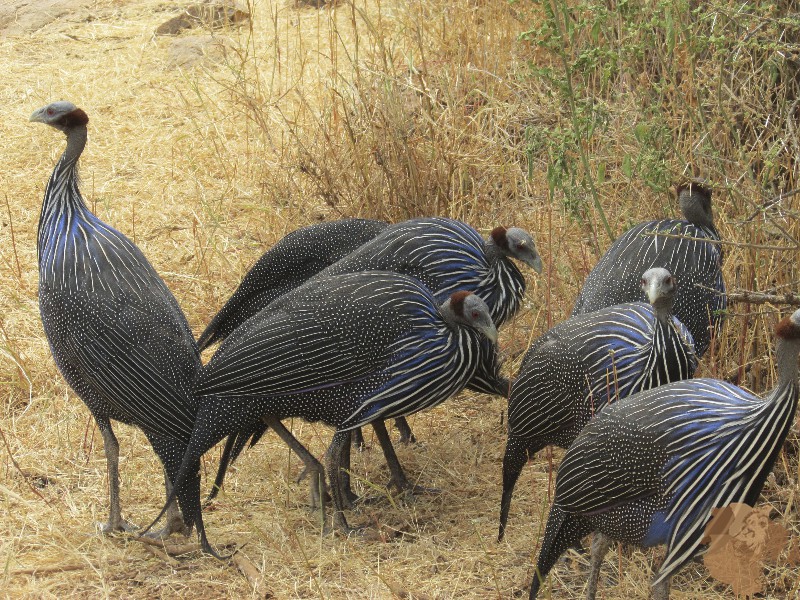 Vulturine guinea fowl
Vulturine guinea fowl
The vulturine guinea fowl inhabits much of Somalia, southern Ethiopia, Tanzania and Kenya. It lives in flocks of 30 individuals in the savannah, dry bush, scrubs, acacia woodland, forest edges and grassland with trees. Guinea fowls are hardy birds suitable for a range of climatic conditions. At night, the birds roost in trees. The call of the guinea fowl is like a high-pitched song. The International Union for Conservation lists the guinea fowl as a lower risk because its numbers appear to be stable throughout its distribution range.
Unique physical characteristics
What gave the bird its name is the appearance of the bluish-gray coloured bare skin of the upper neck and head that is very similar to vultures. The lower rear neck shows some short, beautiful, white and black erected feathers. Wings and the tapered tail have the same pattern. The under-wings show grayish-white flight feathers and spotted-white coverts. These feathers dance when it moves, giving it an elegant posture. The borders of the secondary flight feathers are lilac in color. Lanceolate, elongated, black and white hackles overlay the cobalt-blue breast and back. The cobalt-blue color contrasts strongly with the black and dark gray body plumage with fine white spots. The male and female of vulturine guinea fowls have similar plumage. But in size, the female is slightly smaller than the male. The bill is horn-coloured and de-curved with a broad base, typical of the Galliformes species. The eyes are red, and the feet and long legs are dark gray.
Wining and dining
Guinea fowls spend the day scraping the ground looking for food. They eat seeds, insects, tubers and fallen fruits. Guinea fowls consume all non-conventional feeds and have excellent foraging capabilities. They are quick enough to grab a rodent or a small snake and can go for a long time without water.
Defense against threats
The main predators of guinea fowls are raptors. Monkeys steal their eggs and chicks. When confronted, these social birds are likely to run than fly but when they take to the air, they are high fliers.
Raising in farms
Commercial farming of guinea fowl is at its nascent stage in Kenya but is generating a considerable amount of interest. Some people raise guinea fowls for their ornamental value. But they are mainly raised for their eggs and flesh. The meat is tender and nutritious with a flavour similar to other birds. It is lush and lean in essential fatty acids.
Best breeding practices
The reproduction season of guinea fowl starts at the onset of the rainy season. The birds that are breeding can be confined in houses or put on the free range during the laying period. Some breeders use artificial insemination where the birds are caged, and males are kept separately in cages. They mate in pairs if females and males in the flock are equal numbers. But higher fertility rates occur in flocks where the ratio of male and female is approximately one to 5 hens. Sometimes, domestic roosters cross with guinea hens. The chicks of such cross are sterile.
Laying of eggs
Guinea fowls lay eggs during the rains and few weeks that follow. They start to lay eggs in the 17thweek. In the wild, females lay about twelve eggs in scrapes under small shrubs lined with grass. Guinea hens lay eggs for 6 to 9 months. In captivity, the period can be extended using artificial lighting. Under proper management, a guinea hen reared on soil lays around 100 eggs whereas caged guinea hens lay as many as 180 eggs over a laying period of 40 weeks in a year. The hen can lay eggs for three years. Hatching eggs should be collected at least four times in a day. But under extreme conditions frequent collection is recommended. The eggs weigh 40g. The shells are hard making it difficult to test fertility by candling. The hard shell of the eggs of guinea fowls provides low keeping quality and minimum breakage. Poultry farmers hatch eggs either naturally or artificially.
Hatching eggs naturally
Because guinea hens are too wild, chicken hens hatch guinea eggs, as they can be more adaptable. Such natural methods of incubation are perfect for small flocks. They need to be brooded for four weeks to avoid mortality. Guinea chicks are called keets. As soon as the guinea keets hatch and start to move about, the hen is likely to leave, abandoning the unhatched eggs. These eggs may hatch if they are placed under another hen or in an incubator. A single hen can hatch around 12 eggs. Hens should be treated for lice beforehand.
Hatching eggs artificially
For bigger flocks, incubators are the best. If artificial, they must be at a temperature of 15.5 to 18.50C. Forced-draft incubators must be at 370C and 58% humidity. Hatchability declines with increasing storage time. Turning the eggs regularly every day for 21 days for crossbreeds and 24 days for guineas is highly recommended. The incubation period for guinea eggs is 28 days, and the chicks fly after ten weeks.
Special keet diet
The starter diet for the chicks should contain 24% protein for the first four weeks, and 20% protein until eight weeks. The finisher diet should include 16% protein until market age. By then, they should have reached an average weight of 2kg. The guinea fowl in its lifetime consumes 43 kilograms of feed. The nutritional characteristics are very close to those for chicken.
Easy but beware
Guinea fowls are either sold alive or dressed. The birds are ready for the market at 18 weeks of age. Guinea fowls do not require expensive and complicated housing. Moreover, domestic guinea fowls are usually resistant to pests, more tolerant to aflatoxin and mycotoxin and are not very susceptible to many diseases as compared to chickens. The only limitation is that the birds are noisy and cannot be reared near to houses. And producers need to be sure of the demand before embarking on production.
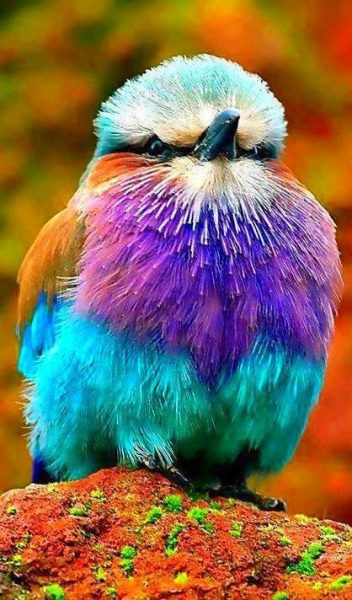 Serious birders
Serious birders
Some nature lovers describe the birds in great detail and create accounts for subsequent research. Thanks to their recent attempts made to photograph and preserve the findings of the remains of the birds, people interested in the study of birds have been able to peruse their documented records.
Scant information
Ornithology is probably one field of study that is left unsearched to a large extent. Most of the accounts on birds are shallow descriptions such as their identification features, behavior and ecology. Not enough people have carefully observed or researched the evolutionary traits of these birds. Literature and publications about the exotic and rare birds of Kenya is so scant and scarce that serious learners would have to visit a local library or the national museum in the country for more identification-related information, as they are readily accessible in the public domain.
Limitations
We need more research to study and understand these birds in detail. Hence, treat any descriptions of such birds of Kenya merely as a guide and not as the ultimate fact. Excluded above are the birds that more frequently occur and typically easy to spot with little effort. The explanation is very brief and terse due to practical considerations. There is room for more field studies in this area. Perhaps you can dedicate some parts of the safari to that.
Bird safari
Unlike a standard game drive, you can do a bird safari at your own pace allowing for the time needed for a detailed study of the birds nearby. A birding safari is best mostly in Lake Baringo, Kakamega, Lake Naivasha, Lake Nakuru and Meru. During such expedition, the guides cater for a structure where you can watch and observe the behavioural patterns of the birds in depth with minimal interruptions.
To receive a colourful digibook about birds with videos, images and text, please fill out the following form or simply email us on safaris@safari-center.com

